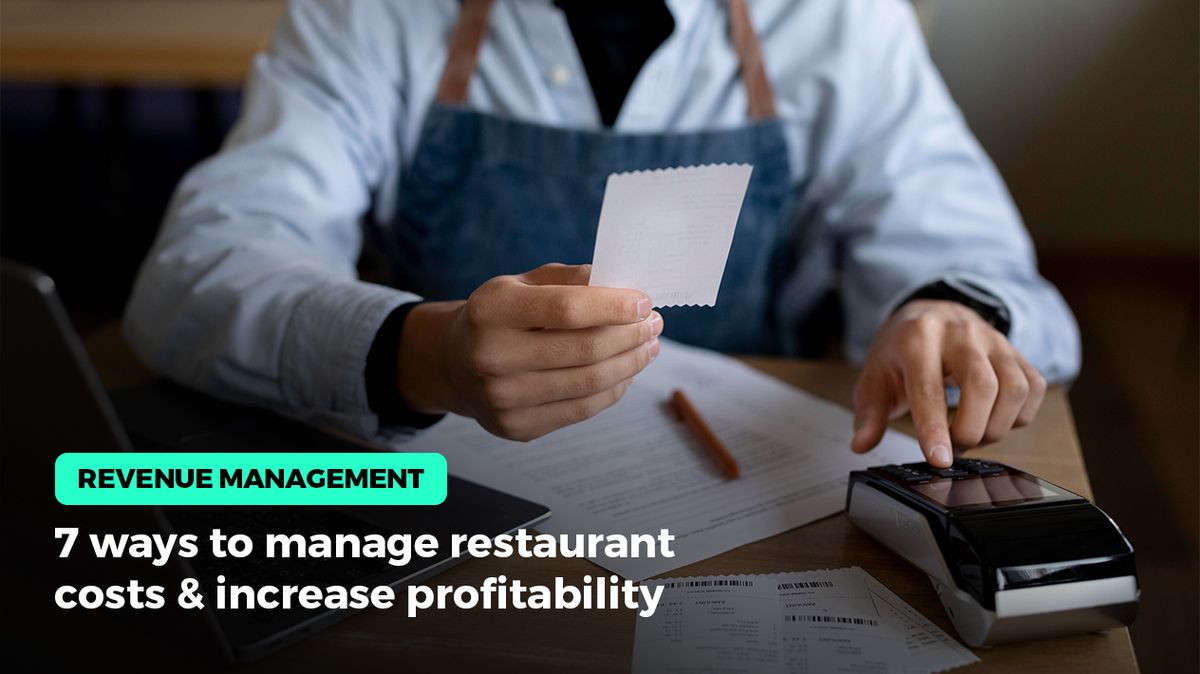Revenue management: 7 ways to manage restaurant costs and increase profitability

Today's businesses are required to pay the necessary attention to revenue management techniques in order to improve operational restaurant finances and increase profitability. This is because of the intense competition and the numerous benefits some businesses offer. Maximizing revenue in a competitive market can be accomplished with a comprehensive plan or a revenue management system tailored to the type of business.
Below are seven key strategies you can implement to improve restaurant finances and pave a successful path in the food and hotel industries. But first, we will discuss the factors that impact those businesses and the market today.
What general developments are affecting businesses today?
Internal and external changes continually impact the hospitality industry. Regarding developments outside of this industry, after being forced to confront a very severe economic crisis for an entire decade, companies were also forced to deal with the consequences of the pandemic. Now that both of these crises have passed, businesses should recover and accelerate in order to catch up with the most recent market developments.
The hospitality field is changing, centered on ecology and the need to preserve the environment. In addition, food delivery and takeaways have increased dramatically. Companies lacking the services mentioned above have a difficult time competing. In addition, there are changes οn how businesses are promoted. Revenue managers have to deal with plenty of developments while forming restaurant finance.
7 revenue management techniques to reduce restaurant expenses and increase profitability
1) Food Delivery
As previously stated, delivery is one of the most popular services experiencing a significant increase, especially during the pandemic. Due to the intense competition, most restaurants and other businesses collaborate with multiple third-party delivery apps.
Cooperating with a delivery app is advantageous if you wish to gauge the success of your business, as your total sales will increase and you will become known to a larger audience. Providing they are satisfied, individuals you supply via delivery may visit your business, and in this way, you will acquire new customers.
Now is the time to cooperate with an online delivery app!
2) Onboarding + Training
Proper onboarding and training in ensuring the success of your business. Maximizing revenue necessitates you have a team capable of providing exceptional services that encourage customers to return to your store. Moreover, your staff should be superior to competitors and invested in the business. How could this occur?
Initially, you will need to allocate resources to a well-structured and functional hiring program in which you will search for the ideal candidate from a large pool of CVs. In addition, you should continually train your employees to seamlessly integrate into the team, fostering trusting relationships and a positive environment.
Competition between staff members is never beneficial, so you will need to foster an environment in which everyone is happy for one another's success. Training should continue indefinitely, and company programs can help employees feel like a cohesive unit. In this manner, you will generate a sufficient competitive advantage to overcome obstacles and rivals.
3) Suppliers + Inventory control
Suppliers and inventory are two of the most critical determinants of the operation's finances, as both can quickly increase or decrease the company's financial flexibility. You can save substantial money by locating the most dependable and cost-effective suppliers, improving your long-term profits.
When searching for suppliers, it is essential to consider both price and quality. You may be able to find a great deal, but if the quality of the product is inferior, you will have wasted your money.
In addition, it is advantageous to locate the suppliers mentioned above and not switch them. When you build trust with a supplier, they may always provide you with high-quality products. In contrast, with a new supplier, there is always the issue of trust and quality.
On the other hand, it is essential to maintain inventory control in order to maximize profits. This involves monitoring usage, ordering, and storing food properly to ensure it is fresh when served. Additionally, you should always be aware of the precise number of supplies, their expiration dates, and their quality, and be able to accurately calculate what you will need for the next period. It can prevent overbuying as well as waste, thereby increasing the profit margin. This reduces food waste, which we will discuss further below.
4) Food Waste
Food waste is essential to combating climate change in the hospitality sector. Food waste begins with managing the inventory properly and ends on the customers' plates, ensuring that the correct quantities are used and no food is wasted. In the meantime, you have to deal with the cooked portions that have not been placed on plates and can be shared later. In addition to improving the environment, reducing food waste also benefits the restaurant's bottom line because with proper care, the correct quantities are cooked, and no food is wasted.
5) Customer preferences + Menu
To ensure the success of your business, it is crucial to understand your customers. This can be done in two ways. Firstly, observe what customers order repeatedly and which dishes they do not order.
On the other hand, you can ask clients directly about their food experience in your restaurant. You can also ask them to fill out a manual or digital questionnaire in which they will answer questions about their meal, their whole experience, what they loved and didn't, and what they want to see from you in the future.
In this manner, the managers proceed with a forecast demand for how the business's menu will be reshaped in the future. Moreover, adjusting the menu according to customers' preferences means you acquire loyal customers who come to the company repeatedly and build a solid customer base. To create this base, you can also run some loyalty programs.
Also, remember that customers who feel welcomed and appreciated are more likely to generate positive reviews and recommend the restaurant to people they know. You want a customer’s first visit to be a remarkable one.
Rewarding loyal customers helps ensure they’ll stay with you long-term. Offering a reward program, such as allowing them to earn points for each visit, can incentivize them to return. After accumulating specific points, they can exchange them for discounts or earn free meals.
Customer loyalty programs can also attract customers that have never been to the business before. Those programs can run through coupons or daily specials to encourage them to stop in and experience your restaurant.
6) Digital Marketing initiatives
Marketing is one of the most essential means of publicizing your restaurant and its services. First, you should have accounts on all popular social media platforms, such as Instagram, Facebook, and TikTok, to upload content and run ads to promote your space and services.
Advantageously, social networking advertisements and content should both be personalized. Social media marketing is a virtually cost-free way to interact with customers and expand your brand by publishing content from your dishes and space. Additionally, having a user-friendly and up-to-date website is essential, as many customers visit restaurant websites to find menus and contact details.
If you want as many local customers as possible, consider investing in pay-per-click (PPC) ads (Google Ads) and social media ads, but make sure they are geo-targeted. Only geo-targeted ads allow you to reach the most relevant audience. Additionally, participating in local events and festivals, such as music festivals and seasonal celebrations, can increase your restaurant's exposure and attract new customers. This will increase the number of potential customers aware of your business.
7) Employee Scheduling Apps
Employee scheduling apps are essential for the correct distribution of shifts. Apps for shift scheduling play a crucial role in reducing restaurant expenses and boosting profits. By automating the scheduling process, these applications eliminate time-consuming manual tasks such as paper schedules, thereby saving both time and money.
You can easily create schedules corresponding to the restaurant's demand patterns, minimizing overstaffing and understaffing issues. This efficient allocation of labor resources improves customer service and reduces labor costs. In addition, shift scheduling apps provide real-time visibility into employee availability and enable seamless communication between managers and staff, facilitating effective shift swaps and reducing shift gaps.
Conclusion
Consider your business as a brand. What your brand stands for is what your customers receive. Consequently, your brand advocacy should focus on food waste, business visibility through social media, onboarding and training, food delivery, customers, suppliers, inventory control, and employee scheduling due to the past decade's trends and the ones that will come in the future.
